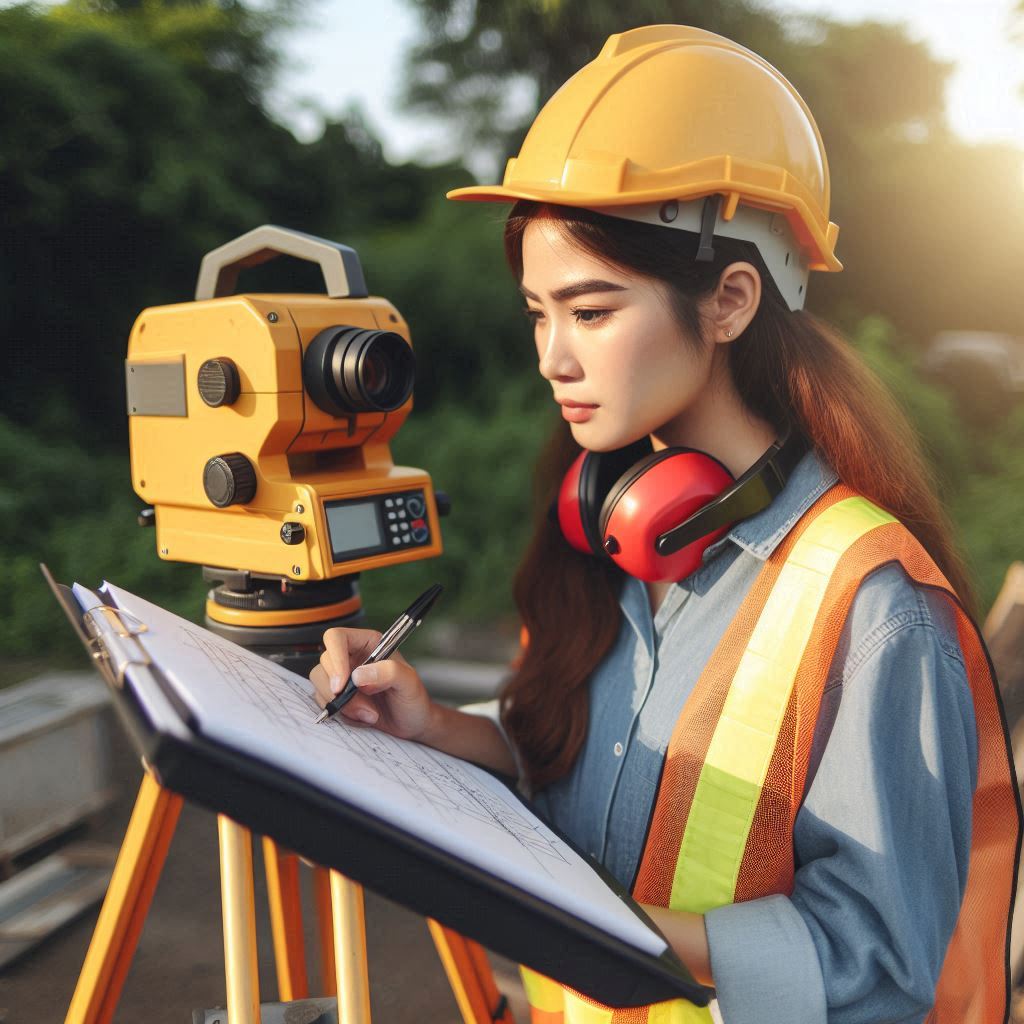Introduction
Field Office Work in Surveying and Mapping are critical professions that play a fundamental role in collecting and analyzing spatial data.
These fields involve measuring land, creating maps, and providing accurate geographical information crucial for various industries such as construction, real estate, and urban planning.
Surveyors are responsible for both gathering field data and processing this information to produce detailed maps and plans.
The work in surveying and mapping is divided between field and office tasks.
Fieldwork involves on-site data collection, where surveyors use specialized equipment like GPS and total stations to measure land and inspect sites.
This hands-on work requires physical presence and often involves traveling to diverse locations.
On the other hand, office work involves analyzing the collected data, using software to create maps, and preparing detailed reports.
This role requires technical skills in data interpretation and mapping software.
Understanding the division between field and office work is crucial for professionals in this field.
Each role requires distinct skills and offers unique challenges.
Fieldwork demands physical endurance and expertise in using measurement tools, while office work requires analytical skills and proficiency in software applications.
Recognizing these differences helps individuals make informed decisions about their career paths and better prepare for their roles in surveying and mapping.
Field work in surveying and mapping
Definition of Field Work in Surveying
Fieldwork in surveying involves collecting data directly from physical locations.
Surveyors use specialized equipment to measure land and gather spatial information.
This data forms the foundation for creating accurate maps and plans.
Fieldwork requires traveling to various sites and working in different environmental conditions.
It provides the raw data needed for detailed analysis and planning in the office.
Responsibilities and Tasks of Field Surveyors
Field surveyors are responsible for a range of tasks essential for accurate data collection.
They operate equipment such as total stations, GPS devices, and leveling instruments.
Surveyors measure distances, angles, and elevations to establish property boundaries and land features.
They inspect sites for potential issues or discrepancies in data.
Recording observations and ensuring data accuracy are critical parts of their role. Field surveyors also prepare sketches and notes to support data analysis later.
Coordination with other team members and communication with clients are often required.
Skills Required for Successful Field Work
Successful fieldwork requires a combination of technical and personal skills.
Surveyors must have proficiency in using various measurement tools and technology.
Strong analytical skills are crucial for interpreting data accurately.
Physical stamina and endurance are necessary for handling outdoor work in various weather conditions.
Attention to detail ensures the accuracy and reliability of collected data.
Good problem-solving abilities help surveyors address unexpected challenges on-site.
Effective communication skills are important for interacting with clients and team members.
Organizational skills are also vital for managing data and documentation efficiently.
Challenges and Opportunities of Working in the Field
Working in the field presents several challenges and opportunities.
Surveyors often face unpredictable weather conditions, which can impact data collection and working comfort.
They may need to navigate difficult terrain, which requires physical effort and careful planning. Safety is a significant concern, as working in remote or hazardous areas poses risks.
However, fieldwork offers opportunities for hands-on experience and direct interaction with the land.
It provides a chance to develop practical skills and gain insights into diverse environments.
Field surveyors can enjoy a dynamic work environment, avoiding the monotony of office routines.
Additionally, field experience enhances problem-solving abilities and offers a deeper understanding of surveying challenges.
Therefore, fieldwork in surveying is a crucial aspect of the profession, involving direct data collection, diverse responsibilities, and specific skills.
While it presents challenges, it also offers valuable opportunities for hands-on learning and practical experience.
Understanding these aspects helps surveyors excel in their roles and contribute effectively to their projects.
Office work in surveying and mapping
Definition of Office Work in Surveying
Office work in surveying involves processing and analyzing data collected from field surveys.
This role is crucial for transforming raw data into useful information.
Office surveyors use specialized software and tools to create detailed maps, perform calculations, and generate reports.
Their work supports the overall surveying process by ensuring accuracy and clarity in the final outputs.
Responsibilities and Tasks of Office Surveyors
Office surveyors handle a range of responsibilities and tasks.
They start by reviewing and organizing field data to prepare for analysis.
Using Geographic Information Systems (GIS) and other software, they process this data to create accurate maps and models.
They conduct calculations to determine land boundaries, elevations, and other critical measurements.
Office surveyors also generate comprehensive reports that detail their findings and recommendations.
These reports are essential for clients, stakeholders, and regulatory bodies.
Additionally, they ensure that all work complies with relevant standards and regulations.
Skills Required for Successful Office Work
Successful office work in surveying requires a specific set of skills.
Strong analytical abilities are crucial for interpreting data and performing calculations.
Proficiency with surveying software, such as GIS and CAD systems, is essential for creating accurate maps and models.
Attention to detail is vital to ensure that all data is processed correctly and that reports are error-free.
Good organizational skills help office surveyors manage large volumes of data and meet deadlines efficiently.
Communication skills are also important, as surveyors must convey complex information clearly to clients and team members.
Challenges and Opportunities of Working in the Office
Working in the office presents several challenges and opportunities.
One challenge is managing the volume and complexity of data, which requires both time and precision.
Office surveyors often work with large data sets and must ensure that their analysis is thorough and accurate.
Another challenge is staying updated with the latest software and technology, which requires continuous learning and adaptation.
However, the office environment also offers significant opportunities.
It allows surveyors to develop expertise in advanced software tools and data analysis techniques.
Working in the office provides a chance to contribute to diverse projects and collaborate with other professionals, such as engineers and planners.
Office surveyors can also focus on strategic planning and project management, roles that can lead to career advancement.
Basically, office work in surveying plays a critical role in the surveying process.
It involves processing field data, creating maps, and generating reports.
Office surveyors need strong analytical, technical, and organizational skills to succeed.
While there are challenges, such as managing complex data and keeping up with technology, the role offers opportunities for professional growth and development.
Comparison of field and office work
Contrasting Differences in Daily Tasks and Responsibilities
Fieldwork in surveying and mapping involves hands-on tasks outdoors.
Technicians measure land, set up equipment, and collect data on-site.
They navigate different terrains and face weather conditions.
Their tasks include taking precise measurements, recording data, and verifying information.
Fieldwork demands physical endurance and the ability to adapt to varying environments.
Office work, by contrast, is conducted indoors.
Surveyors and mappers analyze data, create maps, and prepare reports.
They use computer software to process information and develop visual representations.
Tasks involve reviewing field data, drafting plans, and coordinating with other professionals.
Office work requires strong analytical skills and attention to detail.
Similarities in Required Skills and Knowledge
Despite the differences, both field and office work in surveying and mapping require similar skills and knowledge.
Proficiency in surveying principles and techniques is essential.
Technicians need to understand measurements, data analysis, and mapping conventions.
Both roles require attention to detail and accuracy. Communication skills are also crucial for sharing findings and collaborating with team members.
Benefits and Drawbacks of Each Type of Work
Fieldwork offers the benefit of varied environments and practical experience.
Technicians enjoy being outdoors and seeing immediate results from their efforts.
However, fieldwork can involve challenging weather conditions and physically demanding tasks.
It often requires long hours and travel to remote locations.
Office work provides a stable environment and consistent working conditions.
It offers the opportunity to focus on detailed analysis and map creation.
However, office work can be less dynamic, with less direct interaction with the physical world.
It often involves long periods of sitting and working at a computer.
Opportunities for Career Growth and Advancement in Each Sector
Both field and office roles offer distinct career growth opportunities.
In fieldwork, technicians can advance to roles such as project manager or field supervisor.
Experience in diverse projects and environments can lead to specialized positions or consultancy roles.
In the office sector, career growth often involves progressing to senior roles such as GIS analyst or cartographer.
Advanced positions may include project coordinator or technical director.
Skills in software and data analysis can open doors to leadership roles or advanced technical positions.
In review, field and office work in surveying and mapping each have unique characteristics.
Fieldwork provides hands-on experience and outdoor challenges, while office work offers stability and detailed analysis.
Both paths require similar skills but offer different benefits and career growth opportunities.
Technicians can choose their path based on their preferences for work environment and career aspirations.
Read: Tips for Writing Environmental Engineering Reports
Importance of collaboration between field and office surveyors
Need for Effective Communication and Teamwork Between Field and Office Workers
Effective communication and teamwork between field and office workers are fundamental to the success of surveying and mapping projects.
Field technicians are responsible for collecting critical data and measurements directly from the site, while office staff analyze this data to produce accurate maps and reports.
The accuracy of the final product depends heavily on how well these two teams communicate and collaborate.
Field technicians must relay detailed observations and potential issues to the office team, and vice versa, to ensure that all aspects of the project are synchronized.
Clear and timely communication between field and office teams is essential to avoid misunderstandings and errors that could derail a project.
Without effective collaboration, projects are more likely to encounter delays, inaccuracies, and other issues that can compromise their success.
Examples of How Collaboration Enhances Project Outcomes
Collaboration between field and office teams can significantly enhance project outcomes by leveraging the strengths and insights of both groups.
For example, consider a construction project where field technicians discover unexpected soil conditions that differ from initial assessments.
By promptly communicating these findings to the office team, the project managers can adjust their data models and design plans to account for the new information.
This proactive adjustment prevents costly redesigns and ensures that the project proceeds smoothly.
Another illustrative example is the integration of drone-captured imagery with traditional surveying methods.
Field technicians use drones to capture high-resolution aerial images, which are then processed and analyzed by the office staff.
The combination of these advanced images with traditional surveying data results in highly detailed and accurate topographic maps.
This integration improves the precision and quality of the final product, showcasing how collaboration enhances project outcomes through the effective use of diverse tools and data sources.
Transform Your Career Today
Unlock a personalized career strategy that drives real results. Get tailored advice and a roadmap designed just for you.
Start NowStrategies for Improving Collaboration Between the Two Sectors
Improving collaboration between field and office sectors requires implementing several effective strategies.
Regular meetings and status updates are crucial for ensuring that both teams are aligned on project goals, timelines, and progress.
These meetings provide an opportunity to discuss any issues, share updates, and adjust plans as needed.
Implementing real-time data-sharing systems is another key strategy.
These systems enable field technicians to upload data instantly, allowing office staff to access and analyze this information without delay.
This immediate sharing helps in making timely decisions and adjustments.
Cross-training field and office teams on the latest technologies and methodologies can also improve collaboration.
Understanding each other‘s roles and challenges fosters a greater appreciation of the work involved and enhances teamwork.
Additionally, creating a shared platform for documentation and communication centralizes project information.
This platform can include tools for tracking project status, exchanging feedback, and documenting issues, ensuring that both teams are well-informed and able to address problems promptly.
Impact on Overall Project Efficiency and Quality
The impact of effective collaboration on overall project efficiency and quality is substantial.
When field and office workers collaborate seamlessly, projects experience fewer errors and delays.
Effective teamwork leads to faster problem resolution and more accurate outcomes, significantly enhancing the overall efficiency of project execution.
By addressing issues promptly and making necessary adjustments based on real-time data, projects are completed more quickly and to a higher standard.
The quality of the final deliverables improves as both teams work together to ensure that all data is accurate and well-integrated.
This collaboration ultimately results in greater client satisfaction, as projects are delivered on time and meet or exceed expectations.
The combined efforts of field and office teams, when effectively managed, contribute to the success of surveying and mapping projects, demonstrating the critical role of communication and teamwork in achieving optimal results.
Read: Sustainable Wastewater Treatment Methods

Technology and its role in field and office work
Advancements in surveying technology for both field and office work
Over the years, technology has greatly advanced in the field of surveying and mapping, revolutionizing the way professionals collect and analyze data.
In the field, surveyors now have access to high-tech tools such as GPS, drones, and LiDAR technology that allow them to capture accurate measurements and create detailed maps.
These advancements have significantly improved the efficiency and accuracy of data collection in the field, making it easier for surveyors to complete their work quickly and accurately.
In the office, surveying software has become more sophisticated, enabling professionals to process and analyze data with greater precision.
This has streamlined workflows and allowed for better integration of data from various sources, leading to more comprehensive and detailed mapping projects.
How technology has transformed workflows and processes in the industry
The integration of technology in surveying and mapping has completely transformed the way work is done in the industry.
In the past, surveyors relied on manual methods and traditional tools to collect and analyze data, which was time-consuming and prone to errors.
With the advent of advanced technologies such as GPS, drones, and LiDAR, surveyors can now gather data more quickly and accurately, allowing them to produce more detailed and precise maps.
Additionally, the use of surveying software in the office has automated many processes, saving time and reducing the risk of human error.
As a result, workflows have become more efficient and streamlined, leading to better overall project outcomes.
Benefits and challenges of incorporating technology in surveying and mapping
There are several benefits to incorporating technology in surveying and mapping work.
One of the main advantages is the increased efficiency and accuracy of data collection, which results in more precise maps and measurements.
Additionally, technology allows surveyors to access data in real-time, improving communication and collaboration between field and office teams.
However, there are also challenges to consider when adopting new technologies.
For example, there is a learning curve associated with using advanced tools and software, which can take time for professionals to master.
Additionally, there may be costs involved in upgrading equipment and training staff, which could pose a barrier to implementation.
Future trends in technology and their potential impact on field and office roles
Looking ahead, it is clear that technology will continue to play a crucial role in surveying and mapping work.
Future trends in technology, such as the rise of artificial intelligence and machine learning, are likely to further revolutionize the industry.
These advancements have the potential to automate more processes, analyze data more efficiently, and improve overall project outcomes.
As a result, field and office roles may evolve to focus more on data interpretation and decision-making, rather than manual data collection and processing.
It will be important for professionals in the industry to stay abreast of these developments and adapt to new technologies in order to remain competitive in the field.
Read: Environmental Engineering and Marine Conservation
Training and education requirements for field and office surveyors
Differences in Educational Background and Certification for Field and Office Workers
Field and office roles in surveying and mapping require different educational backgrounds and certifications.
Field surveyors typically need a strong foundation in practical skills.
An associate’s or bachelor‘s degree in surveying, geomatics, or a related field is often required.
They must also obtain certification from recognized bodies, such as the National Society of Professional Surveyors (NSPS).
Field workers usually gain hands-on experience through internships or entry-level positions.
Office workers in surveying and mapping generally require a more technical educational background.
A bachelor‘s degree in surveying, geographic information systems (GIS), or a related field is common.
They often pursue advanced certifications, such as Geographic Information Systems Professional (GISP) or Professional Land Surveyor (PLS).
Office roles focus on data analysis and map creation, which necessitates proficiency in software applications and data interpretation.
Importance of Continuing Education and Professional Development
Continuing education and professional development are crucial in both field and office roles.
Technology and methods in surveying and mapping evolve rapidly.
Staying updated through ongoing education helps professionals remain competitive.
For field surveyors, this may involve learning about new measurement technologies or techniques.
For office workers, it often includes mastering advanced software tools and data analysis methods.
Professional development ensures that both field and office workers maintain high standards of accuracy and efficiency in their work.
Opportunities for Specialization in Either Field or Office Work
Both field and office roles offer opportunities for specialization.
In fieldwork, technicians can specialize in areas such as hydrographic surveying, construction surveying, or environmental surveying.
These specializations require additional training and certifications specific to each field.
In office roles, professionals can focus on specialties like GIS analysis, cartography, or spatial data management.
Specializing in either area can enhance career prospects and lead to advanced positions within the industry.
Resources and Programs Available for Surveyors to Enhance Their Skills and Knowledge
Surveyors have access to various resources and programs to enhance their skills and knowledge.
Professional organizations, such as the American Congress on Surveying and Mapping (ACSM) and the International Federation of Surveyors (FIG), offer educational resources and networking opportunities.
Online platforms provide courses on advanced surveying techniques, GIS, and data analysis.
Universities and technical schools offer continuing education programs and certifications.
Additionally, industry conferences and workshops present opportunities to learn from experts and stay current with industry trends.
These resources support ongoing professional growth and skill development for both field and office surveyors.
Read: Environmental Engineering Software and Tools
You Might Also Like: Day in the Life of a Materials Engineer
Evolution of surveying and mapping practices
Surveying and mapping practices have undergone significant evolution over the years.
From ancient civilizations using rudimentary tools to modern technologies revolutionizing the industry, the field has come a long way.
Historical Perspective
In ancient times, surveying and mapping were crucial for land measurement and property boundaries.
Land surveyors used simple tools like chains and compasses to measure distances and angles.
The accuracy of these early surveys was limited, leading to inconsistencies in land ownership.
With the advent of more advanced tools like the theodolite and total station, surveyors were able to gather more precise data.
This improved accuracy in mapping and allowed for more efficient planning and development of land.
The introduction of GPS technology further revolutionized surveying, enabling surveyors to pinpoint locations with unparalleled accuracy.
Impact of Technological Advancements
Technological advancements have had a profound impact on both field and office work in surveying and mapping.
Field surveyors now have access to laser scanners, drones, and satellite imagery, which allow for faster data collection and more detailed mapping.
In the office, surveyors use computer-aided design (CAD) software to process and analyze the data collected in the field.
This software enables them to create detailed maps, 3D models, and simulations for various projects.
The use of Geographic Information Systems (GIS) has further enhanced the capabilities of office work, allowing for the integration of various data sources and layers for comprehensive mapping.
Showcase Your Business Today
Reach thousands of readers actively exploring professional services. Publish your business profile and grow your audience now.
Publish NowChanges in Industry Standards
As technology continues to advance, industry standards and best practices in surveying and mapping have also evolved.
Professional organizations like the American Society of Civil Engineers (ASCE) and the National Society of Professional Surveyors (NSPS) have established guidelines to ensure the quality and accuracy of surveys.
The use of drones for aerial surveys, LiDAR technology for detailed mapping, and real-time kinematic (RTK) GPS for precise positioning are now commonplace in the industry.
Surveyors are required to stay updated on the latest trends and tools to remain competitive in the field.
Future Outlook
The future of surveying and mapping as professions looks promising, with continued advancements in technology and increased demand for accurate geospatial data.
As urbanization and infrastructure projects continue to expand, the need for land surveyors and mappers will only grow.
Automation and artificial intelligence are also expected to play a significant role in the future of surveying.
Machine learning algorithms can analyze large datasets quickly, while autonomous surveying vehicles can cover vast areas efficiently.
These developments will streamline the surveying and mapping process, making it more cost-effective and accurate.
Ultimately, the evolution of surveying and mapping practices has been driven by technological advancements, changing industry standards, and a promising future outlook.
As professionals in the field, surveyors must adapt to these changes and embrace new tools and techniques to stay relevant in the industry.
Conclusion
Field and office work in surveying and mapping represent two distinct yet complementary aspects of the profession.
Each role has unique responsibilities that contribute significantly to project success.
Field work involves hands-on activities such as collecting site data, measuring distances, and performing inspections.
Surveyors in the field work directly with the environment, dealing with real-time challenges and ensuring that measurements are accurate.
This role requires physical presence, practical problem-solving skills, and the ability to adapt to changing conditions on-site.
In contrast, office work focuses on analyzing the data collected from the field, creating detailed maps, and preparing reports.
Surveyors working in the office use specialized software to process data, generate visual representations, and ensure that all information is accurately documented.
This role demands strong analytical skills, attention to detail, and technical expertise in various tools and applications.
Office work is crucial for transforming raw data into actionable insights and ensuring that the results meet project requirements.
Both field and office roles are integral to achieving successful project outcomes.
Field work provides the essential data and real-world context needed for analysis, while office work ensures that this data is accurately processed and effectively communicated.
[E-Books for Sale]
The Big Book of 500 High-Paying Jobs in America: Unlock Your Earning Potential
$19.99 • 500 High-Paying Jobs • 330 pages
Explore 500 high-paying jobs in America and learn how to boost your career, earn more, and achieve success!
See All 500 High-Paying Jobs of this E-Book
1001 Professions Without a Degree: High-Paying American Jobs You Can Start Now
$19.99 • 1001 Professions Without a Degree • 174 pages
Discover 1001 high-paying jobs without a degree! Unlock career tips, skills, and success strategies for just $19.99!




